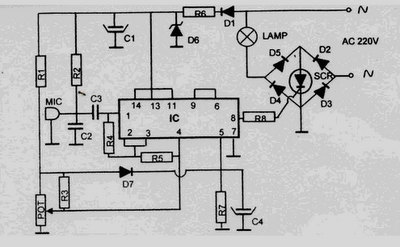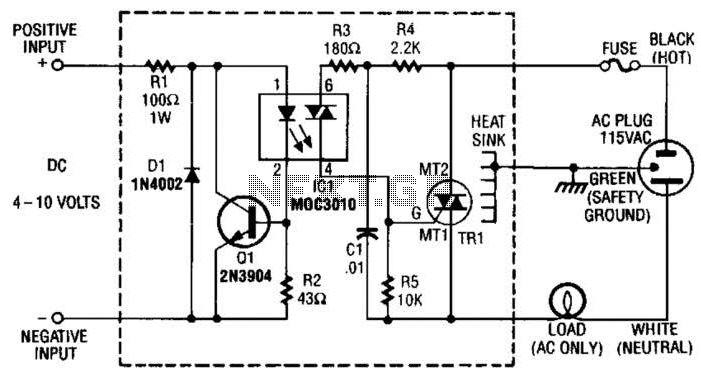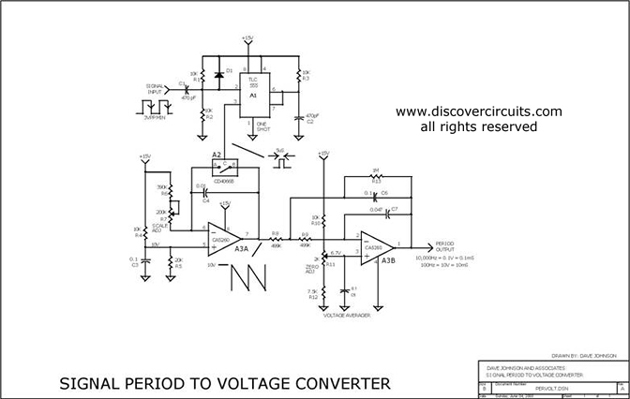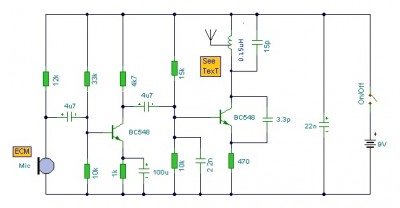
220 volt disco lamp circuit

This 220 Volt disco lamp circuit is not a voice switch (VOX), as it cannot differentiate between musical sounds and human voices. Instead, it functions as a sound-activated device. An interesting application of this circuit is to control the lighting in a disco automatically based on the musical output from a high-power amplifier when the music signal dominates the sound environment. A schematic diagram of the light nightclub circuit is provided below. The circuit can utilize either a microphone coil or a condenser microphone. It is essential to ensure that the electrolytic capacitor is rated for 16 volts or higher. The potentiometer depicted in the diagram serves to adjust the gain of the pre-amplification stage, allowing for proper sound level adjustments to activate the relay.
This 220 Volt disco lamp circuit operates by detecting sound levels to trigger lighting effects, making it suitable for use in nightclubs and similar environments. The circuit's primary components include a microphone, which captures sound, and a pre-amplifier stage that enhances the audio signal. The sound signal is processed to determine its amplitude, and when it exceeds a certain threshold, it activates a relay. This relay then controls the power to the disco lamp, allowing for synchronized lighting that responds to the music's intensity.
The choice of microphone is crucial; a microphone coil or a condenser microphone can be employed, depending on the desired sensitivity and frequency response. The circuit's design must ensure that the electrolytic capacitor is adequately rated to handle the voltage, providing stability and reliability during operation. The potentiometer included in the schematic allows for fine-tuning of the gain in the pre-amplification stage. This adjustment is vital to ensure that the circuit can effectively differentiate between ambient noise and the desired sound levels, preventing false triggering of the relay.
In summary, the disco lamp circuit is a straightforward yet effective solution for creating an engaging visual experience that complements musical performances. The integration of sound activation technology with lighting control enhances the atmosphere in entertainment venues, providing an interactive experience for the audience. Proper component selection and circuit design are essential for optimal performance and reliability in various sound environments.This 220 Volt disco lamp circuit is not a voice switch (VOX), because this circuit is too dumb to differentiate between musical sound and human voice. This is more of a voice-activated sound activated. An interesting application is to control the lighting in your disk automatically by the musical sound of high-power amplifier, when the music signa
l is dominating the sound space. Light nightclub circuit schematic diagram is shown below. You can use the microphone coil or condenser microphone for this circuit. Make sure that the electrolytic capacitor is rated for 16 volts or more. The potentiometer is shown in the diagram is used to adjust the gain of the pre-amplification. You can adjust this knob to get a proper sound level of the relay would be activated. 🔗 External reference
This 220 Volt disco lamp circuit operates by detecting sound levels to trigger lighting effects, making it suitable for use in nightclubs and similar environments. The circuit's primary components include a microphone, which captures sound, and a pre-amplifier stage that enhances the audio signal. The sound signal is processed to determine its amplitude, and when it exceeds a certain threshold, it activates a relay. This relay then controls the power to the disco lamp, allowing for synchronized lighting that responds to the music's intensity.
The choice of microphone is crucial; a microphone coil or a condenser microphone can be employed, depending on the desired sensitivity and frequency response. The circuit's design must ensure that the electrolytic capacitor is adequately rated to handle the voltage, providing stability and reliability during operation. The potentiometer included in the schematic allows for fine-tuning of the gain in the pre-amplification stage. This adjustment is vital to ensure that the circuit can effectively differentiate between ambient noise and the desired sound levels, preventing false triggering of the relay.
In summary, the disco lamp circuit is a straightforward yet effective solution for creating an engaging visual experience that complements musical performances. The integration of sound activation technology with lighting control enhances the atmosphere in entertainment venues, providing an interactive experience for the audience. Proper component selection and circuit design are essential for optimal performance and reliability in various sound environments.This 220 Volt disco lamp circuit is not a voice switch (VOX), because this circuit is too dumb to differentiate between musical sound and human voice. This is more of a voice-activated sound activated. An interesting application is to control the lighting in your disk automatically by the musical sound of high-power amplifier, when the music signa
l is dominating the sound space. Light nightclub circuit schematic diagram is shown below. You can use the microphone coil or condenser microphone for this circuit. Make sure that the electrolytic capacitor is rated for 16 volts or more. The potentiometer is shown in the diagram is used to adjust the gain of the pre-amplification. You can adjust this knob to get a proper sound level of the relay would be activated. 🔗 External reference





